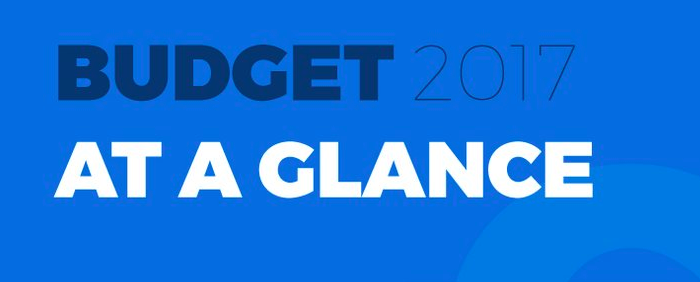
“Farmers for whom we have committed to double the income in 5 years”, said by Mr. Arun Jaitley, Finance Minister of India. The total allocation for the rural, agriculture and allied sectors in 2017-18 is ₹1,87,223 crores, 24% higher than the previous year. The major areas of funds allocations are as follows:
Agricultural credit: The target for agricultural credit in 2017-18 has been fixed at a record level of ₹10 lakh crores, special efforts will be made for the adequate flow of credit to the under-serviced areas including the Eastern States and Jammu & Kashmir. The farmers will also get the benefit of 60 days’ interest waiver of their loans from the cooperative credit structure. Integration of all 63,000 functional Primary Agriculture Credit Societies (PACS) with the Core Banking System of District Central Cooperative Banks to ensure seamless flow of credit to small and marginal farmers.
Faisal Bima Yojana: Coverage of FBY will increase from 30% of cropped area in 2016-17 to 40% in 2017-18 and 50% in 2018-19. The Budget provision has been increased to ₹13,240 crores this year from ₹5,500 crores last year.
Issuance of Soil Health Cards: Government has proposed to set up new mini-labs in Krishi Vigyan Kendras (KVKs) and ensure 100% coverage of issuance of soil health card in all 648 KVKs in the country. In addition, 1000 mini-labs will be set up by qualified local entrepreneurs. The government will provide credit linked subsidy to these entrepreneurs. The real benefit to farmers would be available only when the soil samples are tested and nutrient level of the soil is known.
Long Term Irrigation Fund: a total corpus of this Fund increased to ₹40,000 crores under NABARD compared to ₹20,000 last year. This fund will address the problems of perennial irrigation water crisis that is affecting rural India.
Micro Irrigation Fund: will be set up in NABARD to achieve the goal, ‘per drop more crop’. The Fund will have an initial corpus of ₹5,000 crores. The objective of this fund is to emphasize on all aspects of water conservation.
National Agricultural Market: (e-NAM) coverage will be expanded from the current 250 markets to 585 APMCs. Assistance will be provided to value addition of farmers’ produce by the establishment of cleaning, grading and packaging facilities up to a ceiling of ₹75 lakhs.
Market reforms will be undertaken to denotify perishables from APMC to provide an opportunity to farmers to sell their produce and get better prices. A model law on contract farming would be prepared with the propose to integrate farmers who grow fruits and vegetables with agro-processing units for better price realization and reduction of post-harvest losses.
Dairy Processing and Infrastructure Development Fund: This fund will be set up in NABARD with a corpus of ₹8,000 crores over 3 years, with an initial fund of ₹2,000 crores, this will benefit the farmers through value addition.
Rural Population: providing employment and basic infrastructure
Mission Antyodaya: To make 50,000-gram panchayats poverty free by 2019, the 150 birth anniversary of Gandhiji. A composite index will be developed for poverty free gram panchayats to monitor the progress from the baseline.
MGNREGA: It is focusing on creating productive assets to improve farm productivity and incomes. The last year’s target of 5 lakh farm ponds had already been achieved and about to cross 10 lakhs by March 2017. This single measure will contribute greatly to drought proofing of gram panchayats. Another 5 lakh farm ponds will be taken up this year.
Pradhan Mantri Gram Sadak Yojana (PMGSY): A sum of ₹19,000 crores in 2017-18 have been allocated for this scheme. A total amount of ₹27,000 crores will be spent on PMGSY in 2017-18 with the contribution of states.
Pradhan Mantri Awas Yojana: Allocation for PMAY has been increased to ₹23,000 crores in 2017-18 from ₹15,000 crores of last year to achieve 1 crore houses by 2019 for the houseless and those living in kutcha houses.
Deendayal Upadhyaya Gram Jyoti Yojana: An increased allocation of ₹4,814 crores has been proposed under DUGJY in 2017-18 to achieve 100% village electrification by 1st May 2018.
Deendayal Antyodaya Yojana: Allocations for this Yojana (DAY-National Rural Livelihood Mission for the promotion of skill development and livelihood opportunities for people in rural areas) has been proposed to be ₹4,500 in 2017-18. The allocation for Prime Minister’s Employment Generation Programme (PMEGP) and credit support schemes has been increased more than 3 times.
National Rural Drinking Water Programme: Safe drinking water will be provided to over 28,000 arsenic and fluoride affected habitations in the next four years.
Mason training program: For imparting new skills to the people in the rural areas, by 2022, mason training will be provided to 5 lakh people, with an immediate target of training at least 20,000 persons by 2017-18.
This budget will help in widens the doors for smooth flow of credit to farmers. Also, the crop insurance will strengthen the roots of farmers and soil health cards will help in the reduction of the use of fertilizers. New reforms in APMC act will surely enhance the income of farmers. The focus on capital structure building under MGNREGA, Pradhan Mantri Gram Sadak Yojana will strengthen the infrastructure of the rural area.
So, we can say that overall the budget for agriculture and rural population will help in removing the poverty, building infrastructure and providing better employment opportunities. This budget will help the farmers to step up towards the target of doubling the income by 2022.